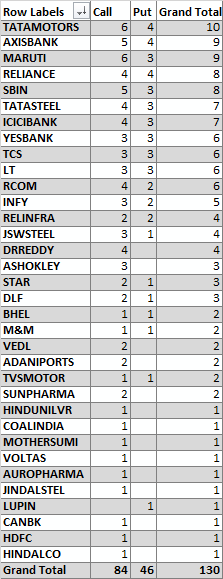
[level-capmind-pro]
If you’re buying and selling stock options, the contract volumes seem to have gone through a sea change in the last couple months. Unfortunately, trading stock options is fraught with not just the risk of time decay, but also of severe illiquidity.
Today we check out how many stocks have “reasonable” liquidity – that is, stocks whose options traded more than 500 contracts today. We consider all stocks only (on the NSE) and here’s the list, divided into stocks, with number of calls/puts at different strikes that have more than 500 contracted today. For instance, if Tata Motors has 6 calls and 4 puts that means 6 different strikes of Tata Motors calls were liquid and traded more than 500 contracts, and 4 different puts were too.

In all of the above, you can see that:
• Only 34 stocks have at least one option trading more than 500 contracts per day.
• Of these, only 13 stocks have more than 1 liquid puts and calls together. This means buying or writing straddles or strangles on stocks has limited appeal – there are only so many stocks with liquid strikes on both directions.
• Some of the big names are absent – like HDFCBank, which is a heavyweight on the Nifty but none of whose options traded more than 500 contracts today
• Banks have the highest liquidity – SBI, ICICIBank, Axis bank and Yes Bank have depth.
• Reliance, Tata Steel, Maruti and Tata Motors are the heavyweights that are liquid.
• Infy and TCS bring in tech, and RCOM figures in the list as well.
The most liquid option today was the Tata Steel 250 call option. This traded about 3041 contracts in total.
Compare that to, say the Nifty where the maximum volume was in the 7600 call, which traded over 219,000 contracts! In fact, even the 8000 put option, which is very deep in the money (the Nifty’s at 7650) traded 7,400 contracts today, which is 2 times the volume of the most liquid stock option.
Remember also that most liquidity is at the open and then at the close. That further restricts you as trading happens
The liquidity equation is very different for the Nifty versus for individual stocks.
This Changes The Rules
With lack of liquidity there should be a certain way to play the options game without subjecting oneself to extreme risk.
With lower volumes you will not find a buyer or a seller easily. You will therefore have to trade carefully and “find” the counterparty, while entering or exiting a trade. For this, you may have to put in bids and wait, while hoping that the stock doesn’t run away.
Do not place market orders. The market order just takes what it can get and the prices may be way too far away from what you wanted.
Do not chase the market. There are algorithms continuously modifying bids and asks to give the semblance of liquidity – they will run away if you place an order too close. If you keep chasing them, they’ll keep running away from you or make you execute at a very unfavourable price. In many option trades where you are paying just Rs. 8 per share, a chase up to Rs. 8.5 can meaningfully change your profit bottomline. You will need to be patient.
Avoid placing Stop Loss orders. Imagine how easy it will be to take out your SL order in an illiquid market. If your stop losses are too close, there is a near guarantee they will be hit by the algos. In illiquid markets, placing a stop loss order might leave you with a lot of whipsaws – where the SL gets hit and then the option rebounds to its original value.
Straddles and Strangles only in the most liquid stocks. Buying a call and a put (or as we have been doing, selling them both) can be a non-directional strategy intended to trade volatility or generate income. You will need to focus such strategies on the most liquid stocks – any option that trades less than 500 contracts a day is too dangerous as it can run away from you.
Trading or hedging a large portfolio through options (like using covered calls or buying stock puts) will need you to have a longer gestation time (entry and exit) in the trade. You may take days to build covered calls on a Rs. 5 crore portfolio of, say, Infosys, and it could take equally long to exit. When trading larger quantities, focus only on liquidity. (Or use the Nifty or Bank Nifty).
This is more important for buyers of options than for sellers. A seller will have to allocate about Rs. 100,000 per contract (margin plus any additions that may be required). An option buyer on the other hand only allocates a premium. So the same Tata Steel 250 call trades at a lot size of 2000 shares, and is at a price of Rs. 6. So an option buyer has to only allocate Rs. 12,000, but an option seller needs to pay Rs. 60,000 as margin at least! So if you had Rs. 60,000 you could buy five contracts, but as a seller you can sell only one contract. This acts as a natural liquidity check for option sellers, but buyers need to be careful that their trades aren’t driving the market.
Having said all of this, options liquidity is only starting to grow in India, and over the next few months everything might change. We just wanted to bring this to your notice so that when your next option trade comes along, you evaluate not just the option itself, but also the liquidity in the market.
![]()
Disclaimer
Nothing in this newsletter is financial advice and should not be construed as such. Please do not take trading decisions based solely on the matter above; if you do, it is entirely at your own risk without any liability to Capital Mind. This is educational or informational matter only, and is provided as an opinion.
Disclosure: The authors at Capital Mind have positions in the market and some of them may support or contradict the material given above, or may involve a direction derived from independent analysis.

[/level-capmind-pro]



